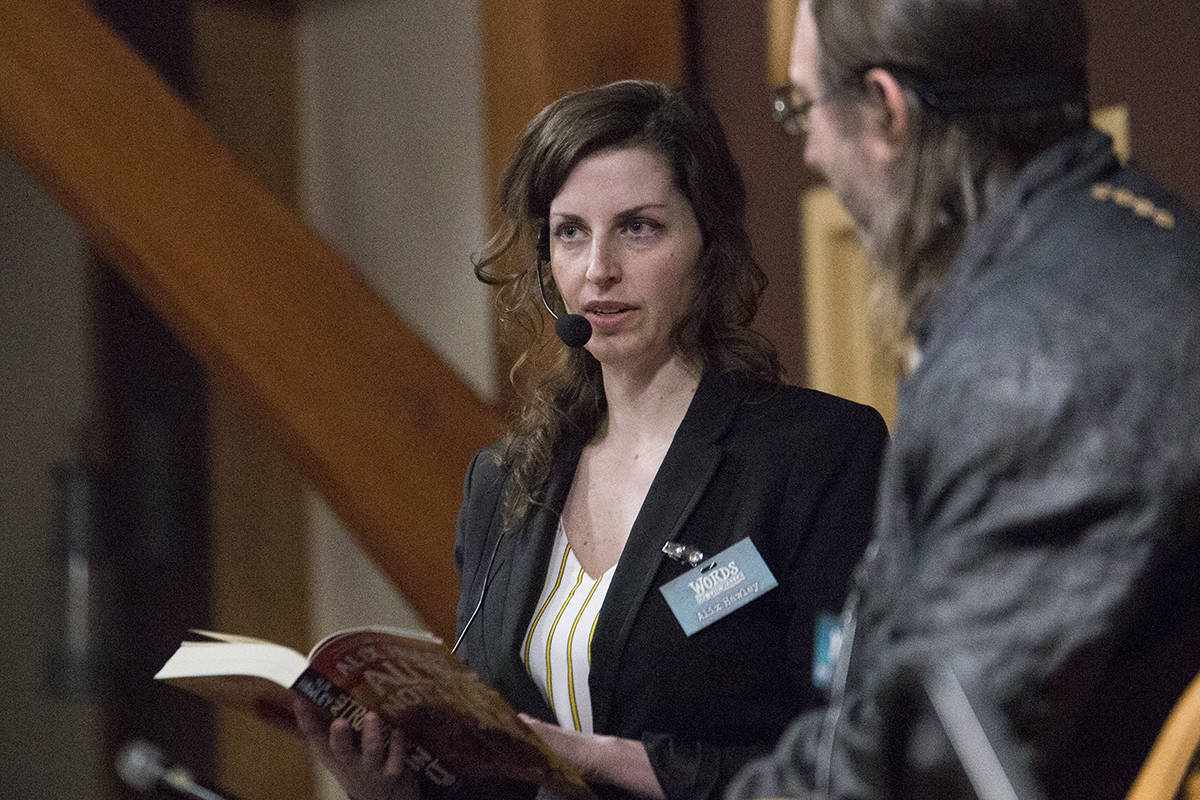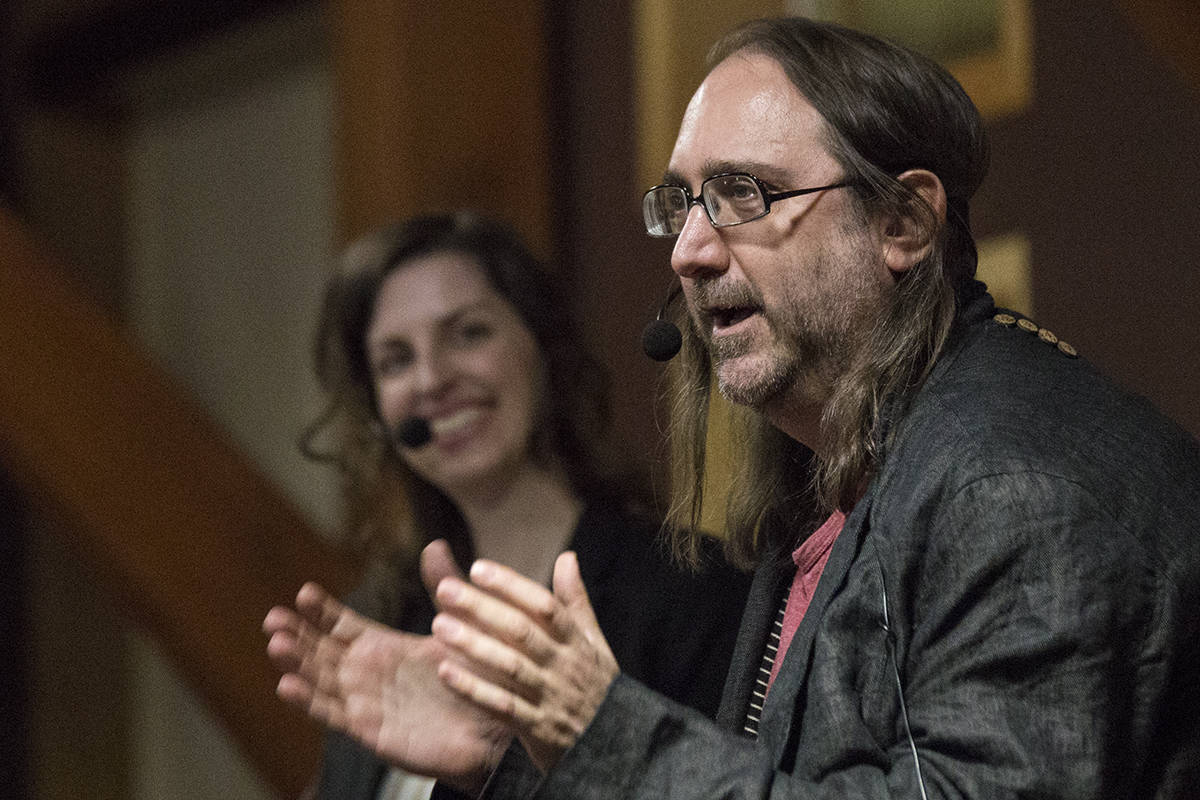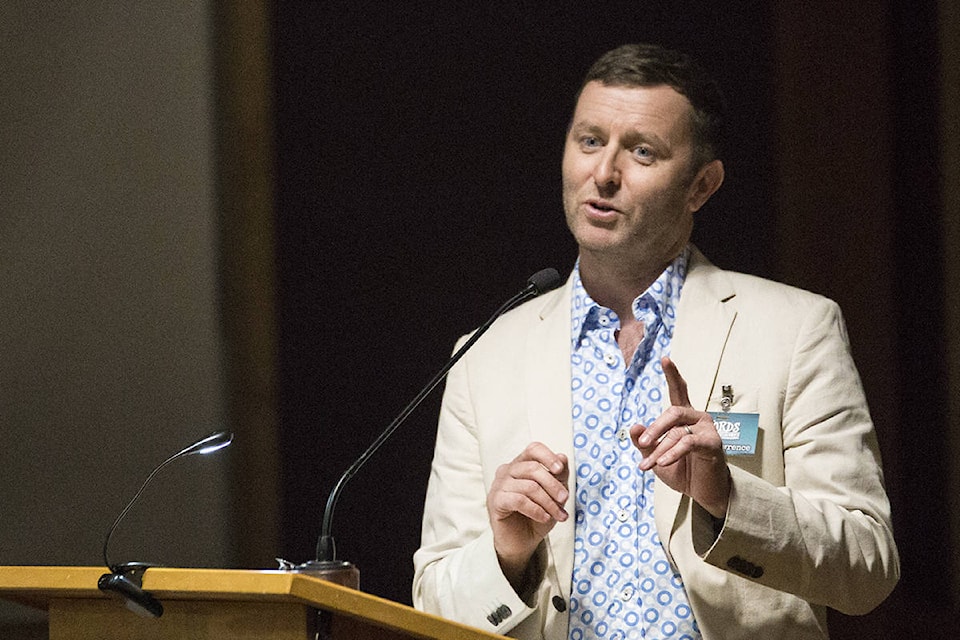Last weekend’s Words on the Water writer’s festival kicked off with Writers in Conversation on Friday evening.
The eight featured authors were paired up to discuss everything from shared histories to how they came up with the beginning of their novel.
Hosted by CBC personality and author Grant Lawrence, the sessions went a little bit like this:
Terry Glavin and Renee Sarojini Saklikar
Glavin is an author, editor and journalist. At the moment he is a columnist for the Ottawa Citizen and the National Post, as well as a regular contributor to Maclean’s. He is the author of seven books and the co-author of three. He resides in Victoria, and he was inspired by and well acquainted with Saklikar’s father.
“I grew up in awe of this man,” Saklikar said. “My dad thought so highly of you.”
Sarojini Saklikar was commissioned to write the poem for this years festival. It is called Water. At the moment she is the Poet Laureate for the city of Surrey. Through that position she offers free writing consultations, teaches poetry in schools and at community events and hosts workshops with seniors and youth. She also teaches creative writing at Simon Fraser University. She has two books published, Children of Air India and The Revolving City: 51 Poems and the Stories Behind Them. At the moment she is working on an epic sci-fi journey poem.
Glavin and Saklikar agree that they are both obsessed with place.
“The questions that animate me, or did when I was young, were not the sort of ‘who am I?’ kind of questions you are supposed to be animated by but more ‘where am I?’ very practical, ‘whose house am I living in? what country is this really? what are the names of these mountains?,’” Glavin said.
That has translated into their writing.
“What I discovered in the researching of this book, Children of Air India, is that the bombers tested their bombs under the surveillance of CSIS and the RCMP in the woods outside of Duncan,” Saklikar said.
Upon looking in to the location Saklikar found out that the location they meant was outside of Paldi.
She read her poem Unauthorized Interjection exploring that place.
“I am kind of imagining a conversation in which we talk about the unnameable–the people who make bombs and put them on planes, and trying to do so in a way that isn’t about stigmatizing, for instance, Sikh men,” she said.
Glavin read an excerpt from Archeaology of Metrotown.
“Where I grew up is now gone and it has been subsumed by a place called Metrotown,” he said. “So I did an archaeology of Metrotown, it’s kind of a history that goes back I think about 4,000 years, we’re not sure… it’s a stone ring that was discovered during a basement renovation on Nelson Avenue and Burnaby.”
Heather O’Neill and Kim Fu
O’Neill write novels, poetry, short-stories and screenplays. Her debut novel was Lullabies for Little Criminals in 2006 and has since published The Girl Who Was Saturday Night, the short story collection Daydreams of Angels and The Lonely Hearts Hotel.
Fu writes poetry and novels among other things. Her writing has also appeared in Granta, the Atlantic, the New York Times, Hazlitt and the Times Literary Supplement. Her published works include the novel For Today I am a Boy, the poetry collection How Festive the Ambulance and her most recent novel The Lost Girls of Camp Forevermore.
Their conversation began with Fu asking O’Neill how her career and her writing has changed since she first started and why she waited to write her most recent novel.
“This novel has kind of been the novel that has percolated the longest for me,” O’Neill said.
The novel was inspired by the rose-coloured gangster culture bedtime stories that her father told her growing up.
“My dad raised me by himself and he was born in 1927 and he was the youngest of nine boys and his father died when he was three so his mother was alone with nine boys and the Great Depression hit so of course they all turned to crime,” she said.
Though he walked the straight and narrow after the second World War he realized it was the greatest mistake of his life because he had missed his true calling, O’Neill said.
“When I was 22 I started writing it and there was like 35 characters and there was about 50 murders and when I was done it was five pages long,” she said.
Years later, going through her dad’s things in the basement she came across the story and decided to go back to it.
“It was so different because for me the female character I had created when I was 22 was just this gangster moll kind of and her name was Rose, but as I wrote this book she became this really dominant, she became the psychopath in the book and she became this cross between like a gangster’s moll and Simone de Beauvoir,” she said.
Fu’s book also came from a fascination within her own life.
“Where I grew up, near Vancouver, I got to go to elementary school until Grade 7 and then start high school in Grade 8,” she said. “So later when I learned about the concept of middle school or junior high I was like ‘that sounds terrifying, why would you ever do that, why would you put those ages together?’.”
She said that girls aged 9-11 are so interesting because there is a huge developmental split, some are already manipulating people and some are doe-eyed little children. She also said that she thinks that is the age that girls’ ‘wild child’ instincts are the most suppressed.
“I wanted to take all those dynamics that they have on the playground, and what if the stakes were a little higher,” she said.
Mark Leiren-Young and Alix Hawley
Leiren-Young is a non-fiction writer, a playwright and a film maker. His novel The Killer Whale Who Changed the World is about Moby Doll, the first orca displayed in captivity. He is currently directing a feature documentary about Moby and directed a short documentary called The Hundred Year Old Whale about Granny (J2) is currently touring film festivals.
Hawley writes short stories and novels. She published The Old Familiar, a collection of short stories, in 2008. Her first novel, All True Not a Lie in It was published in 2015.
Both authors struggled writing the beginning to their novels.
“I had the beginning of this book wrong, in every way, for so long,” Hawley said.
For many drafts, Hawley said she had the entire voice of the novel wrong.
“I started out with a tale of an academic researcher looking back into the life of Daniel Boon, I thought it was amazing. When I sent it to my agent she pretty much replied ‘I hate this’,” she said.
After some sulking she rewrote the story in the third person.
“It started to feel like a pretty bad young adult biography about halfway through that draft but I persevered just to get the plot down,” she said.
That was when she realized it had to be written in first person.
“The beginning was really the hardest part though,” she said. “I started in the wrong place, my editor kept saying this isn’t right, I don’t know how to help you, I can’t fix this, but go make up something else.”
Eventually she went all the way back to when Boone was seven-years-old.
Leiren-Young said he also wrote many drafts and struggled with the opening.
“When I wrote the first draft of this book I thought ‘Oh my god this is the best thing I have ever done,’ I submitted it to my editor who disagreed,” he said. “I remember reading her notes and thinking ‘can I afford to return the advance?’.”
But he eventually realized that his editor was correct and sat down to rewrite it.
“In terms of the opening… I’m trying to think how many times I rewrote what is a 400 word opening,” he said. “I just kept writing it and the idea was, ‘how do I get to 1964?’.”
David Chariandy and Bev Sellars
David Chariandy is a novelist and writing teacher. He has published two award winning novels, Soucouyant and Brother.
Bev Sellars, our Haig Brown Writer in Residence, wrote a memoir of her experience in residential school They Called Me Number One. She has also published a second book Price Paid: The Fight for First Nations Survival.
Was there ever a moment where something you wrote made one of the real people that you mention by name upset? Chariandy asked.
“No not at all,” Sellars said. “The reason that I didn’t second guess myself is that I reached out. For every former student that I talk about in the book I reached out to them and asked them whether I could use their name.”
Reaching out to those former classmates was also a form of research for Sellars, she said that they helped her fill in the blanks for events that she didn’t quite remember.
“It took me 20 years to write that book and it took you 10 years to write Brother,” Sellars said. “I was hoping that you could tell us what it was like to write Brother.”
Chariandy said it was a long process as he needs to fail at writing something over and over again before he knows he has got it right.
“That’s a very slow way of writing,” he said.
Was it traumatic, going back and remembering in order to write this book? Chariandy said.
“It fulfills what I think can be the magic of writing, putting us there in that situation, a girl in residential school and having us feel and see,” he said, and that must have been difficult.
Sellars said she cried enough tears to fill a swimming pool, writing that book.
“I didn’t start writing it as a book to begin with, I started writing it because we started trying to understand why there was so much social problems in our communities,” she said.
The more she investigated, the more she found that all roads lead back to the residential school.
“It took me 20 years to write the book and I’d put it away for awhile and just let things percolate and I would get back to it when I could again,” she said. “It was a painful journey that I was on.”
Words on the Water continued on Saturday morning with each reader discussing their works for 45 minutes followed by an evening finale where they all came together once again.


